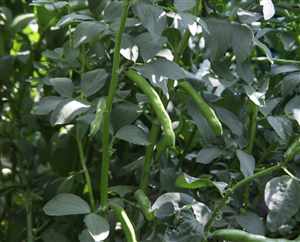Broad bean (Vicia faba), Fava Bean, Velvet Bean
Main Facts about Broad bean

Using Broad bean
Broad beans are an excellent vegetable source of protein and fibre. This may be a winning combination for weight loss. Low fat content helps bodybuilders stay lean while gaining muscle. Broad beans are also rich in both folate and B vitamins, which we need for nerve and blood cell development, cognitive function and energy. If you have Parkinson’s disease, talk to your physician before eating broad beans. They are a natural source a levodopa, which is converted into the neurotransmitter dopamine, one of the medications used to treat the symptoms of Parkinson’s. Levodopa stimulates the pituitary gland to produce Human Growth Hormone (HGH) -the most powerful anti-aging substance known that keeps everything working smoothly in your body like when you were a teenager. Contains vitamin B17, known as the cancer-beating vitamin. People who eat folate-rich foods like fava beans regularly may have a decreased risk of heart disease, cancer and depression. Fava beans are a very good source of phosphorus in the body, which is required for the formation of healthy bones and teeth. In addition, it also helps the body utilize vitamins. Fava beans have potassium which helps maintain blood pressure and regulate the heart. Lots of vitamin A for healthy skin, good vision and bone development. Helps lower LDL- bad cholesterol.Broad bean is a remedy for: Weight loss
Caution!
Start easy to test one or two because a small percentage of people might have a bad allergic reaction known as favism (an enzyme deficiency called G6PD deficiency). Symptoms include sudden jaundice, anemia and blood in the urine.Cooking with Broad bean
Fava beans can be served raw or cooked, though the bean pods must first be blanched and the mature seeds shelled before eating. Broad beans are used in the same general way as Lima and navy beans. They are an integral part of many soups, stews and pasta dishes. The fresh young growing tips of the beans are used in the same way as pea shoots, steamed, poached or lightly sauteed. Fresh fava beans have to be cooked and prepared within one week and should be consumed within two days of cooking. If you are using dried beans, take only half of the amount of beans required, as they will become almost double after cooking.How to grow Broad bean
The broad bean is a cool weather crop, grown in late fall, winter and spring, but seldom in the summer in any but the coolest of regions. It tolerates most soils, though it does poorly in saturated soil, but otherwise it is hardy and versatile. When intended for consumption, fava beans are planted in February and March to mature through the summer, with their peak coming in July.| Black walnut |
Broccoli
|